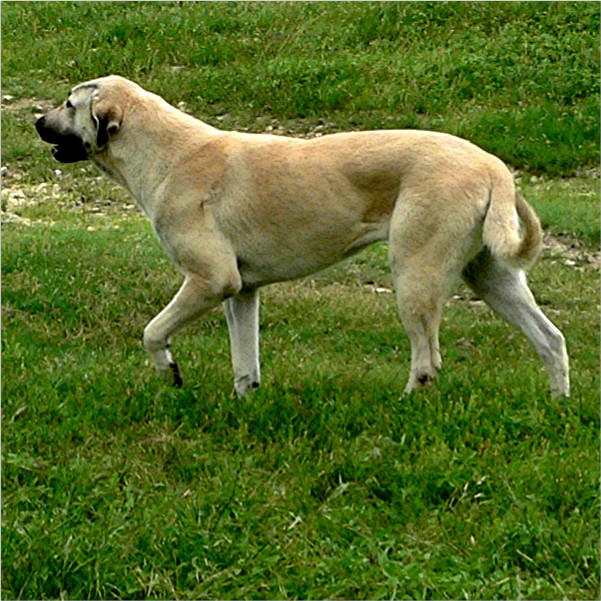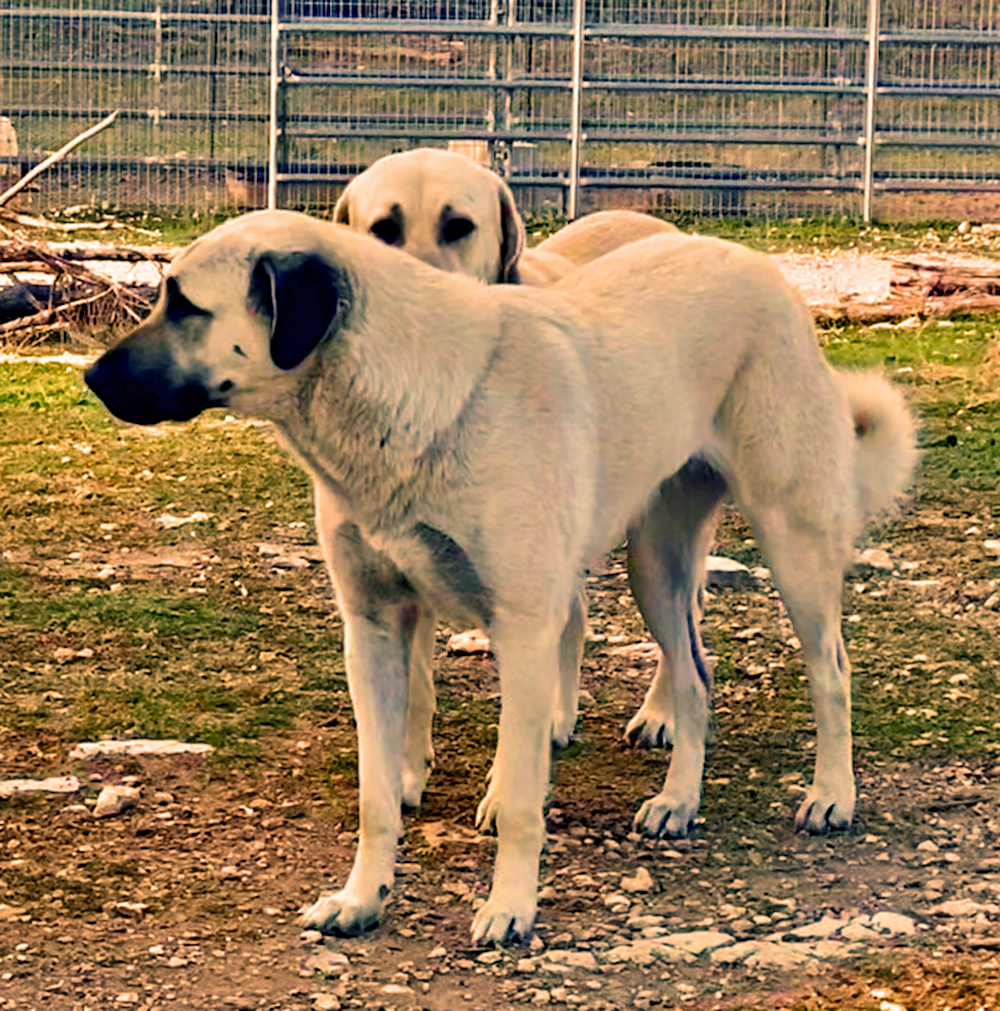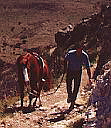Anatolians living in a working environment (with sheep and/or goats in a predator rich environment)
must survive numerous predator attacks throughout their lifetimes while defending their charges.
Wolf packs, pig packs, and mountain lions create special dangers for the Anatolian guardian.
When the Anatolian is outnumbered (wolf, dog, and pig packs) or is dealing with a predator
with great speed and power (mountain lion or bear), the Anatolian MUST possess a unique balance
of agility and power to have the greatest chance of survival. One of the main physical attributes
an Anatolian must have to achieve this balance of agility and power when leaping and whirling during
a life-or-death battle to protect the Anatolian's charges and their own life is a correct topline.
The correct Anatolian topline is described in the Anatolian Standard.
The Anatolian Standard states "Topline will appear level when gaiting. Back will be powerful,
muscular, and level, with drop behind withers and gradual arch over loin, sloping slightly
downward at the croup."
|
What is that? Anatolian toplines need to "appear level" AND "drop behind withers" AND have
a "gradual arch over loin" AND "sloping slightly downward at the croup!" All that dropping,
arching, and sloping doesn't sound like my definition of level! What is the Anatolian Standard
trying to convey?
If you say the Topline will appear level when gaiting, you might be implying that the topline
isn't actually level when standing. (As you see, it certainly isn't described as
level in the Anatolian Standard.) The Anatolian Topline can't be LEVEL when the Standard
says the topline drops behind the withers to a level Back and then gradually arches over
the loin and slopes downward at the croup. That isn't level! And remember, the Standard
says "appear level when gaiting!"
In 2005, I read an excellent description of a correct Anatolian topline written by one of AKC's
most highly respected Anatolian judges, Judge Richard G. Beauchamp. He described the Anatolian
topline as a "Powerful topline dropping gently behind withers with a gradual arch over the loin
sloping slightly downward at the croup (an elongated or 'lazy s' from withers to tail)." I loved
this description because it had been (and continues to be) my observation that Anatolians who
possess the greatest agility and speed when leaping and whirling during a serious and potentially
deadly fight also have a definite observable arch over their loins.
Looking at the genetic origins of Anatolians, I discovered research conducted by Elaine Ostrander
and Heidi Parker, geneticists at the National Human Genome Research Institute in Bethesda,
Maryland, and their colleagues, who spend 20 years looking into how all the breeds developed.
They sampled no less than 1346 dogs covering 161 breeds (not quite half of all kinds of dogs).
They built a family tree by comparing the differences at 150,000 locations on each dog's genome.
The results allowed them to group the 161 breeds into 23 larger groups, called clades, based
on their common genetic ancestries. The clades were genetically generated and it was observed
that these clades tended to bring together dogs with similar traits.
The Anatolian Shepherd was a part of a dog clade that included Salukis, Afghan hounds, Sloughis,
Great Pyrenees, Pharoah Hounds, Ibizan Hound, Komondor, and Kuvasz. I was fascinated
to see no mastiffs included in this genetically produced clade.
Seeing the number of sighthounds in the Anatolian clade, I realized some sighthounds
have toplines with the "lazy s" structure and a gradual arch over their loin. I thought
I might learn more about why Anatolians are required to have an arch over the loin if
I examined why other breeds require an arch over the loin. I discovered that all breeds
requiring the arch over the loin understand that the arch over the loin benefits
their breeds' ability to perform. I noticed that the Ibizan Hound topline is described
in a manner quite similar to the Anatolian topline and has similarities I believe are
important.
The article, "Conformation and Structure," found on the Amberlithe Ibizan Hounds webpage,
provides some enlightening information about a misunderstanding among some Ibizan
breeders that the Ibizan topline should be flat. This isn't true in either Ibizan
hounds or Anatolians. The author states "There should be a rise above the withers
that supports the longer spires of the backbone." These longer vertebral spires,
used for greater muscular attachment, are required for "strong well laid-back shoulders."
Strong well laid-back shoulders are also required in Anatolians. The author also states
that "the back is only that hand span behind the withers and in front of the loin."
From the withers there is a drop to the back followed by a definite rise over the loin. This does not describe
a flat topline either. In fact, it seems to describe the "lazy-s" structure described
by Judge Beauchamp when describing the Anatolian topline.
"The Ibizan Hound is a galloping, jumping athletic rabbit hunter." While Anatolians must
have great endurance at the trot, when a predator is located, Anatolians gallop at great
speed to drive off the predator. If they meet resistance and the predator fights, Anatolians
become jumping, leaping, and whirling blurs of speed and agility. Anatolians with a flat
and under-muscled loin and no arch to their topline have greatly reduced athletic ability
in the performance of these leaping and whirling maneuvers, resulting in a reduced ability
to survive dangerous predator encounters. Anatolians with weak loins lack endurance
and suffer in old age!
While some might think a flat topline looks
attractive in an Anatolian trotting across a ring, knowledgeable working Anatolian
breeders understand how dangerous the flat topline is to the survival of their
working Anatolians. When I see an Anatolian with a flat topline, I see an Anatolian
that will have trouble surviving dangerous predator encounters!
Anatolians need to be able to leap and whirl with superior speed and agility. To ensure
the preservation of this required speed and agility, breeders must identify Anatolians
with a long straight/level topline (a topline with no gradual arch over the loin) and
when breeding these "straight/level backed" Anatolians with reduced agility, give special
consideration to selecting a breed pairing with an Anatolian whose arched topline matches
the arched "lazy s" topline described in the Anatolian Standard. Breeders must improve the
toplines of their improperly straight-backed Anatolians to insure Anatolians maintain
the structure required to have the greatest chance of survival.
Anatolians with their short backs (the vertebrae between their withers and their loin)
can transfer forward motion more efficiently. The long, well-muscled, and arched loin
of the Anatolian generates great agility and turning ability in
the breed as well as enhanced power. The Anatolian croup must be sloped to allow their
large thigh muscles to bunch and drive with the greatest power possible.
As reworded by Judge Richard G. Beauchamp, look for an Anatolian with a "Powerful
topline dropping gently behind withers with a gradual arch over the loin sloping slightly
downward at the croup (an elongated or 'lazy s' from withers to tail)."
We breed for this "lazy s" topline, required by the Anatolian Standard, rather than a
"straight/level" topline, because the "lazy s" topline improves Anatolian survival
rates in true working situations.
The Anatolian structure was shaped by its function as a livestock protector for thousands
of years. The gradual rise over an Anatolian's well-muscled loin, specifically required
in the Anatolian standard, has an important breed purpose, to ensure the Anatolian can
make spectacular leaps and whirl with speed and agility during the life-or-death battles
the Anatolian engages in to protect its charges. Any change in structure that compromises
athletic speed and agility when fighting predators is detrimental to the breed.
Unfortunately, there are an increasing number of Anatolians with significantly flatter,
almost straight, (perfectly level?) toplines; the gradual arch over the loin, as required
in the Anatolian Standard, is absent. As these flat-backed young Anatolians age, many
become sway-backed, losing speed and agility even further! Because Anatolian toplines
without the arched loin are so detrimental to the breed, I believe that Anatolians
without the required arched loin should be severely penalized in the ring. The removal
of the required arched loin in Anatolian structure is not a minor fault. It is not harmless.
It negatively affects the functioning ability of the working Anatolian. In the pasture,
we can count on the help of dangerous predators to insure Anatolians automatically
retain the arched loin because powerful predators will eliminate those Anatolians who
lack a correctly arched loin!

CHAMPION Inanna BETHANY Bay of LUCKY HIT (BETHANY)
demonstrating a correct Anatolian "lazy s" topline.
You will notice that BETHANY also has a correct front and correct rear assembly.
BETHANY obtained her Championship as a year old pup in only two show weekends.
She took five (5) THREE POINT MAJORS after only two short trips to Petsmart to prepare.
BETHANY lived her life 24/7 guarding goats, ducks, geese, and llamas.
If a predator lurked too near her pasture, BETHANY easily cleared my six foot gate to chase off the predator
and then quickly returned to her charges.
BETHANY'S amazing athletic ability was a product of her correct topline and correct front and rear assembly!
BETHANY PRODUCED 11 CHAMPIONS FROM HER TWO LITTERS.
BETHANY WAS DESIGNATED THE ASDCA 2009 FEMALE TOP PRODUCER AND THE ASDCA 2011 FEMALE TOP PRODUCER!
BETHANY WAS DESIGNATED A DAM OF MERIT in 2011 and A DAM OF DISTINCTION in 2014.
BETHANY EARNED THE TITLE OF THE 2010 NATIONAL SPECIALTY BROOD BITCH.
BETHANY'S NIECE, GRAND CHAMPION LUCKY HIT Shadow LAVANTA (LAVANTA),
WON BEST OPPOSITE SEX, 2010 NATIONAL SPECIALITY, ALL FOUR DAYS!
BETHANY'S SIRE,CHAMPION BIRINCI'S YAHSI of LUCKY HIT (YAHSI), WON BEST OF BREED WESTMINISTER IN 2008.
BETHANY'S LITTER BROTHER CHAMPION Inanna Bay BOUDREAU of LUCKY HIT (BOUDREAU), WON BEST OF BREED WESTMINSTER IN 2010.
|
Another characteristic affecting the appearance of the Anatolian topline is correct
Anatolian demeanor while trotting. An Anatolian positions its head to level, or
just below level, as it trots among the herd. This head position is a signal to the
sheep and/or goats that no trouble is detected and the herd can remain calm. While
trotting with no sign of danger, correctly bred Anatolians with excellent working
demeanor drop their heads on a nearly level plane with the withers and back line
and often below the plane of their back.
This same head position should be maintained in a correctly bred Anatolian while
trotting in the show ring and judges who understand the breed will know this.
In all cases, this level head posture is intended to
convey that the Anatolian doesn't perceive a problem. When the head goes up, in
the pasture or in the show ring, the Anatolian with correct working ability is
signaling that they have noticed potential danger and are on full alert, ready
and prepared to defend and protect!
Interfering with the dog's proper use of this vital behavioral signal selected to
alert the herd to nearby danger will ruin excellent livestock guardian ability -
the essence of the breed! Dogs in the pasture who lack correct sheep/goat communication
will be eliminated because of their failure as effective guardians. Dogs in the ring
must not be ruined as effective livestock guardians by judges who think a dog looks
"so much more beautiful trotting with its head up!" In Anatolians, head-up should always be
a signal that the Anatolian suspects potential danger is nearby!
If an Anatolian maintains a head-up position whether or not danger is perceived,
that Anatolian has lost one of the breed's most important working behaviors -
a head position that correctly conveys the presence of potential danger to their
charges. Judges who select Anatolians trotting with their heads held high no matter
the level of danger will ultimately ruin another working breed!
In addition to vision, Anatolians (like wolves) use scent to perceive danger. When
trotting the Anatolian topline should be similar to the wolf topline. Wolves usually
carry the head hanging, not higher than the level of the back. One of the world's
foremost wolf (Canis Lupis) authorities, Heptner Naumov, author of "Mammals of the
Soviet Union, Volume II, Part 1a, (1998)," states "The wolf is a slender, well-proportioned,
powerful animal. It has a strong trunk with sloping back, with high shoulders and a lower,
but strong and wide croup. The rib cage is large, deeply descending, the abdomen is pulled
in and the neck is powerful and muscular. The limbs are long and strong, the paws are
relatively small and the digits are tightly compressed (in a lump). Head large, heavy,
with strong jaws, a long but not pointed muzzle, and broad forehead…the wolf's head
looks especially 'broad in the forehead.' The animal usually carriers it [the head]
a bit hanging, not higher than the level of the back, and appears slightly stooping,
with its high shoulders. Only the watchful wolf raises its head high." This observation
could almost be the description of an Anatolian.
It is imperative that Anatolian breeders don't fall prey to show ring fads. When judges
favor a level top line, they must not confuse level with "flat." The Anatolian topline
must remain flexible in order for the dog to move and function properly. A level top
line should mean that the withers and croup are on the same plane and the back (five
vertebrae behind the withers) needs to be slightly lower than the withers and loin
to maintain proper flexibility. Judge Richard G. Beauchamp's description continues
to provide excellent guidance. The Anatolian must have a "Powerful topline dropping
gently behind withers with a gradual arch over the loin sloping slightly downward at
the croup (an elongated or 'lazy s' from withers to tail)."
The relative length of the upper arm and the scapula (shoulder blade) is another
aspect of Anatolian structure that affects the topline. The scapula and upper arm
should be the same length and, in Anatolians, they must be positioned to create
a 90 degrees angle between them, 45 degrees upward from the horizontal to the
shoulder blade and 45 degrees downward from the horizontal to the upper arm.
The length of bone and angulation in the rear assembly must not be exaggerated and
must match the front assembly. The rear assembly cannot extend so far back that
the animal loses it secure footing. Just as the rear assembly can require
more extension, the rear assembly can also become too extended. Anatolian structure must
be moderate to function across a broad range of activities required of the breed.
In order to maintain the appearance of a level top line while stacked, it has become a
recent fad among many breeders to extend their dogs' rear assemblies to a position causing
the rear end to function less effectively and break down more quickly. At the same time,
some breeders have incorrectly been breeding straight fronts with short upper arms,
putting the front assembly in front of the dog instead of under it. The combination
of these alterations results in a back that will sway between an incorrectly positioned
front and an overextended rear.
|

 Phone Numbers Link
Phone Numbers Link

 Click Picture to Return to Anatolian Main page
Click Picture to Return to Anatolian Main page Click Picture to Return to Lucky Hit Main Home Page
Click Picture to Return to Lucky Hit Main Home Page